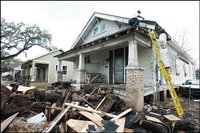Between A Moist Spot And A Wet Place
 This is the reaction by FEMA to people deciding not to raise their homes to a level above the federal governments forthcoming base flood elevations. The problem is that the new flood maps haven't been released yet.
This is the reaction by FEMA to people deciding not to raise their homes to a level above the federal governments forthcoming base flood elevations. The problem is that the new flood maps haven't been released yet.
This puts homeowners between a rock and a hard place. You see, FEMA will ask may people to spend a lot of money to raise their homes but can't tell who needs raising or how high. In the meantime, local governments are encouraging people to return to their neighborhoods or else they will be deemed non-viable.
Many homeowners, however, said they have little choice: Raising their houses would cost too much. Estimates for elevating a house start at $20,000 and some exceed $100,000. FEMA offers as much as $30,000 toward such projects, but many homeowners said that amount would cover only a fraction of their costs.Therein lies their dilema. But where homes must be rebuilt from the ground up, history offers us a solution.
Some of the oldest portions of the city, such as the French Quarter and the Garden District, are built on higher ground, and many older New Orleans houses are built high enough that the front door is as many as 10 steps above the sidewalk. Many of these fared best during the Katrina floods last summer.Rebuilding homes as raised cottages instead of the ubiquitous ranch house offers a few advantages.
"Prior to the '50s and '60s, most of the housing in New Orleans was built raised above the ground," Tulane's Kroloff said. "The regular flooding of New Orleans didn't threaten them."
- The raised cottage will put many homes that flooded above the base flood elevation.
- They will recreate a type of home that is common throughout much of the older parts of New Orleans.
- This style of home is seeing a newfound populararity in some of the newer developments in more suburban areas.
- Raised cottages will, to some extent, bring back some of the charm that exists in more historic parts of New Orleans.

No comments:
Post a Comment